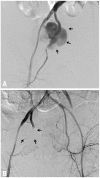Abdominal compartment syndrome due to spontaneous retroperitoneal hemorrhage in a patient undergoing anticoagulation
- PMID: 21319359
- PMCID: PMC3051203
- DOI: 10.3349/ymj.2011.52.2.358
Abdominal compartment syndrome due to spontaneous retroperitoneal hemorrhage in a patient undergoing anticoagulation
Abstract
Spontaneous retroperitoneal hemorrhage is one of the most serious and often lethal complications of anticoagulation therapy. The clinical symptoms vary from femoral neuropathy to abdominal compartment syndrome or fatal hypovolemic shock. Of these symptoms, abdominal compartment syndrome is the most serious of all, because it leads to anuria, worsening of renal failure, a decrease in cardiac output, respiratory failure, and intestinal ischemia. We report a case of a spontaneous retroperitoneal hemorrhage in a 48-year-old female who had been receiving warfarin and aspirin for her artificial aortic valve. She presented with a sudden onset of lower abdominal pain, dizziness and a palpable abdominal mass after prolonged straining to defecate. Computed tomography demonstrated a huge retroperitoneal hematoma and active bleeding from the right internal iliac artery. After achieving successful bleeding control with transcatheter arterial embolization, surgical decompression of the hematoma was performed for management of the femoral neuropathy and the abdominal compartment syndrome. She recovered without any complications. We suggest that initial hemostasis by transcatheter arterial embolization followed by surgical decompression of hematoma is a safe, effective treatment method for a spontaneous retroperitoneal hemorrhage complicated with intractable pain, femoral neuropathy, or abdominal compartment syndrome.
Conflict of interest statement
The authors have no financial conflicts of interest.
Figures


References
-
- Pode D, Caine M. Spontaneous retroperitoneal hemorrhage. J Urol. 1992;147:311–318. - PubMed
-
- Chan-Tack KM. Fatal spontaneous retroperitoneal hematoma secondary to enoxaparin. South Med J. 2003;96:58–60. - PubMed
-
- Bhasin HK, Dana CL. Spontaneous retroperitoneal hemorrhage in chronically hemodialyzed patients. Nephron. 1978;22:322–327. - PubMed
Publication types
MeSH terms
Substances
LinkOut - more resources
Full Text Sources
Medical

